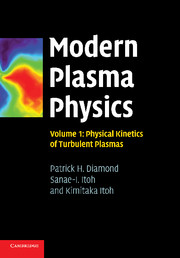Book contents
- Frontmatter
- Contents
- Preface
- Acknowledgements
- 1 Introduction
- 2 Conceptual foundations
- 3 Quasi-linear theory
- 4 Nonlinear wave–particle interaction
- 5 Kinetics of nonlinear wave–wave interaction
- 6 Closure theory
- 7 Disparate scale interactions
- 8 Cascades, structures and transport in phase space turbulence
- 9 MHD turbulence
- Appendix 1 Charney–Hasegawa–Mima equation
- Appendix 2 Nomenclature
- References
- Index
5 - Kinetics of nonlinear wave–wave interaction
Published online by Cambridge University Press: 05 October 2010
- Frontmatter
- Contents
- Preface
- Acknowledgements
- 1 Introduction
- 2 Conceptual foundations
- 3 Quasi-linear theory
- 4 Nonlinear wave–particle interaction
- 5 Kinetics of nonlinear wave–wave interaction
- 6 Closure theory
- 7 Disparate scale interactions
- 8 Cascades, structures and transport in phase space turbulence
- 9 MHD turbulence
- Appendix 1 Charney–Hasegawa–Mima equation
- Appendix 2 Nomenclature
- References
- Index
Summary
A wave is never found alone, but is mingled with as many other waves as there are uneven places in the object where said wave is produced. At one and the same time there will be moving over the greatest wave of a sea innumerable other waves, proceeding in different directions.
(Leonardo da Vinci, “Codice Atlantico”)Introduction and overview
Central issues and scope
After our discussions of quasi-linear theory and nonlinear wave–particle interaction, it is appropriate to pause, to review where we've been, and to survey where we're going. Stepping back, one can say that the central issues which plasma turbulence theory must address may be classified as:
(1) mean field relaxation – how the mean distribution function evolves in the presence of turbulence, and what sort of heating, cross-field transport, etc. results from that evolution. Though much maligned, mean field theory forms the backbone of most approaches to turbulence. Chapter 3 deals with the most basic approach to the mean field theory of relaxation, namely quasi-linear theory – based upon closure using the linear response. Future chapters will discuss more advanced approaches to describing relaxation in a turbulent, collisionless plasma;
(2) response – how the distribution function evolves in response to a test perturbation in a turbulent collisionless plasma. Problems of response including nonlinear Landau damping, resonance broadening theory, propagator renormalization, etc. are discussed in Chapters 3 and 4, on the kinetics of nonlinear wave–particle interaction;
[…]
- Type
- Chapter
- Information
- Modern Plasma Physics , pp. 150 - 207Publisher: Cambridge University PressPrint publication year: 2010

